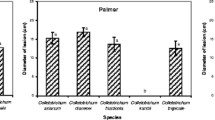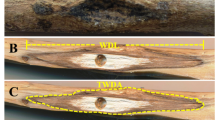Abstract
Over the past two decades, there has been a marked increase in Uruguayan olive production. However, the humid climate of Uruguay creates favorable conditions for the development of olive anthracnose, characterized by fruit rots and blossom blight, which are frequent and destructive symptoms. Several species of Colletotrichum are responsible for the disease, with C. acutatum sensu stricto (s.s) being the most prevalent. This study aimed to analyze the survival of Colletotrichum in an olive orchard with a history of olive anthracnose. For two consecutive years, samples of fruits, leaves, and woody organs were collected monthly from aerial parts of the olive tree. Colletotrichum spp. structures were recorded in a climate chamber, and C. acutatum s.s. was quantified. The study demonstrated that Colletotrichum can survive in different organs of the olive tree, with mummified fruit being the primary survival site, followed by leaves and branches. Among the leaf and woody organs, yellow leaves, leaves from defoliated branches, terminal dry branches, and healthy new branches were identified as important survival sites. Mummified fruits were not always present on the tree throughout the year, and leaves and branches can serve as the primary source of initial inoculum for infections of flowers and fruits in their absence.




Similar content being viewed by others
Data availability
The data supporting this study’s findings are available from the corresponding author upon reasonable request. The data that support the findings of this study are available from.
References
Agostini, J. P., & Timmer, L. W. (1994). Population dynamics and survival of strains of Colletotrichum gloeosporioides on citrus in Florida. Phytopathology, 84(4), 420–425. https://doi.org/10.1094/Phyto-84-420
Børve, J., & Stensvand, A. (2017). Colletotrichum acutatum occurs asymptomatically on apple leaves. European Journal of Plant Pathology, 147(4), 943–948. https://doi.org/10.1007/s10658-016-1050-3
Cacciola, S. O., Faedda, R., Sinatra, F., Agosteo, G. E., Schena, L., Frisullo, S., Di San Lio, G. M. (2012). Olive Anthracnose. Journal of Plant Pathology, 29–44. https://doi.org/10.4454/JPP.V94I1SUP.001
Casanova, L., Hernández, L., Alaniz, S., & Mondino, P. (2016). Sitios y estructuras de sobrevivencia de Colletotrichum spp. causante de la podredumbre amarga del manzano. Agrociencia, 20, 68–73. ISSN 2301-1548.
Chattaoui, M., Raya, M. C., Bouri, M., Moral, J., Pérez-Rodríguez, M., Trapero, A., DMallem, M., & Rhouma, A. (2016). Characterization of a Colletotrichum population causing Anthracnose disease on olive in northern Tunisia. Journal of Applied Microbiology, 120, 1368–1381. https://doi.org/10.1111/jam.13096
Conde, P., & Leoni, C. (2007). Enfermedades del olivo en Uruguay Las Brujas, Canelones. Jornada de divulgación. Resultados experimentales en olivos. INIA. Serie de Actividades de Difusión, N.º 512, 7–11.
Conde-Innamorato, P., Arias-Sibillotte, M., Villamil, J. J., Bruzzone, J., Bernaschina, Y., Ferrari, V., Zoppolo, R., Villamil, J., & Leoni, C. (2019). It is feasible to produce olive oil in temperate humid climate regions. Frontiers in Plant Science, 10, 1544. https://doi.org/10.3389/fpls.2019.01544
Debode, J., Van Hemelrijck, W., Baeyen, S., Creemers, P., Heungens, K., & Maes, M. (2009). Quantitative detection and monitoring of Colletotrichum acutatum in strawberry leaves using real-time PCR. Plant Pathology, 58(3), 504–514. https://doi.org/10.1111/j.1365-3059.2008.01987.x
Filoda, P. F., Arellano, A. D. V., & Dallagnol, L. J. (2021). Colletotrichum acutatum and Colletotrichum nymphaeae causing blossom blight and fruit anthracnose on olives in southern Brazil. European Journal of Plant Pathology, 161, 993–998. https://doi.org/10.1007/s10658-021-02372-y
Iliadi, M. K., Tjamos, E. C., Antoniou, P. P., & Tsitsigiannis, D. I. (2018). First report of Colletotrichum acutatum causing anthracnose on olives in Greece. Plant Disease, 102(4), 820. https://doi.org/10.1094/PDIS-09-17-1451-PDN
Leoni, C., Bruzzone, J., Villamil, J. J., Martínez, C., Montelongo, M. J., Bentancur, O., & Conde-Innamorato, P. (2018). Percentage of anthracnose (Colletotrichum acutatum s.s.) acceptable in olives for the production of extra virgin olive oil. Crop ProteCtion, 108, 47–53. https://doi.org/10.1016/j.cropro.2018.02.013
MGAP-DIEA. (2021). https://descargas.mgap.gub.uy/DIEA/Anuarios/Anuario2021/LIBRO%20ANUARIO%202021%20Web.pdf. Accessed May 2022.
Moral, J., & Trapero, A. (2012). Mummified fruit as a source of inoculum and disease dynamics of olive anthracnose caused by Colletotrichum spp. Phytopathology, 102(10), 982–989. https://doi.org/10.1094/PHYTO-12-11-0343
Moral, J., de Oliveira, R., & Trapero, A. (2009). Elucidation of disease cycle of olive anthracnose caused by Colletotrichum acutatum. Phytopathology, 99, 548–556. https://doi.org/10.1094/PHYTO-99-5-0548
Moral, J., Xavier, C., Roca, L. F., Romero, J., Moreda, W., & Trapero, A. (2014). La antracnosis del olivo y su efecto en la calidad del aceite. Grasas y Aceites, 65, e028. https://doi.org/10.3989/gya.110913
Moreira, V., Mondino, P., & Alaniz, S. (2021). Olive anthracnose caused by Colletotrichum in Uruguay: symptoms, species diversity and pathogenicity on flowers and fruits. European Journal of Plant Pathologhy, 160, 663–681. https://doi.org/10.1007/s10658-021-02274-z
Pereira, J., Bernal, J., Martinelli, L., Villamil, J. J., & Conde, P. (2016). Original olive genotypes found in Uruguay identified by morphological and molecular markers. Acta Horticulturae, 1199, 7–13. https://doi.org/10.17660/ActaHortic.2018.1199.2
Romero, J., Santa-Bárbara, A. E., Moral, J., Agustí-Brisach, C., Roca, L. F., & Trapero, A. (2022). Effect of latent and symptomatic infections by Colletotrichum godetiae on oil quality. European Journal of Plant Pathology, 163, 545–556. https://doi.org/10.1007/s10658-022-02494-x
SAS Institute Inc. (2020). SAS Institute. Cary, NC: SAS Institute Inc.
Schena, L., Abdelfattah, A., Mosca, S., Li Destri Nicosia, M. G., Agosteo, G. E., & Cacciola, S. O. (2017). Quantitative detection of Colletotrichum godetiae and C. acutatum sensu stricto in the phyllosphere and carposphere of olive during four phenological phases. European Journal of Plant Pathology, 149(2), 337–347. https://doi.org/10.1094/PHYTO-04-17-0133-R
Sergeeva, V., Spooner-Hart, R., & Nair, N. G. (2008). First report of Colletotrichum acutatum and C. gloeosporioides causing leaf spots of olives (Olea europaea) in Australia. Australasian Plant Disease Notes, 3(1), 143–144. https://doi.org/10.1007/BF03211271
Sergeeva, V. (2014). The role of epidemiology data in developing integrated management of anthracnose in olives-a review. VII International Symposium in Olive Growing. Acta Horticulturae, 1057. https://doi.org/10.17660/ActaHortic.2014.1057.19
Sharma, G., Maymon, M., & Freeman, S. (2017). Epidemiology, pathology and identification of Colletotrichum including a novel species associated with avocado (Persea americana) anthracnose in Israel. Scientific Reports, 7, 1–16. https://doi.org/10.1038/s41598-017-15946-w
Stensvand, A., Børve, J., & Talgø, V. (2017). Overwintering diseased plant parts and newly infected flowers and fruit as sources of inoculum for Colletotrichum acutatum in sour cherry. Plant Disease, 101(7), 1207–1213. https://doi.org/10.1094/PDIS-11-16-1599-RE
Talhinhas, P., Sreenivasaprasad, S., Neves-Martins, J., & Oliveira, H. (2005). Molecular and phenotypic analyses reveal association of diverse Colletotrichum acutatum groups and a low level of C. gloeosporioides with olive anthracnose. Applied and Environmental Microbiology, 71(6), 2987–2998. https://doi.org/10.1128/AEM.71.6.2987-2998.2005
Talhinhas, P., Neves-Martins, J., Olivera, H., & Sreenivasaprasad, S. (2009). The distinctive population structure of Colletotrichum species associated with olive anthracnose in the Algarve region of Portugal reflects a host-pathogen diversity host post. FEMS Microbiology Letters., 296, 31–39. https://doi.org/10.1111/j.1574-6968.2009.01613.x
Talhinhas, P., Mota-Capitão, C., Martins, S., Ramos, A. P., Neves-Martins, J., Guerra-Guimarães, L., & Oliveira, H. (2011). Epidemiology, histopathology and aetiology of olive anthracnose caused by Colletotrichum acutatum and C. gloeosporioides in Portugal. Plant Pathology, 60(3), 483–495. https://doi.org/10.1111/j.1365-3059.2010.02397.x
Talhinhas, P., Loureiro, A., & Oliveira, H. (2018). Olive anthracnose: A yield-and oil quality-degrading disease caused by several species of Colletotrichum that differ in virulence, host preference and geographical distribution. Molecular Plant Pathology, 19(8), 1797–1807. https://doi.org/10.1111/mpp.12676
Timmer, L. W., Brown, G. E., & Zitko, S. E. (1998). The role of Colletotrichum spp. in postharvest anthracnose of citrus and survival of C. acutatum on fruit. Plant Disease, 82, 415–418. https://doi.org/10.1094/PDIS.1998.82.4.415
Verma, N., MacDonald, L., & Punja, Z. K. (2007). Environmental and host requirements for field infection of blueberry fruits by Colletotrichum acutatum in British Columbia. Plant Pathology, 56(1), 107–113. https://doi.org/10.1111/j.1365-3059.2006.01450.x
Zulfiqar, M., Brlansky, R. H., & Timmer, L. W. (1996). Infection of flower and vegetative tissues of citrus by Colletotrichum acutatum and C. gloeosporioides. Mycologia, 88, 1121–1128. https://doi.org/10.2307/3760791
Acknowledgements
This study was supported by Agroland S.A. and Nuevo Manantial S.R.L.
Author information
Authors and Affiliations
Corresponding author
Ethics declarations
Ethical approval
This article does not contain any studies requiring ethical approval.
Conflict of interest
All authors have no conflict of interest.
Rights and permissions
Springer Nature or its licensor (e.g. a society or other partner) holds exclusive rights to this article under a publishing agreement with the author(s) or other rightsholder(s); author self-archiving of the accepted manuscript version of this article is solely governed by the terms of such publishing agreement and applicable law.
About this article
Cite this article
Ferronato, B., Ingold, A., Moreira, V. et al. Detection and quantification of Colletotrichum survival on olive tree (Olea europaea L.). Eur J Plant Pathol 167, 77–87 (2023). https://doi.org/10.1007/s10658-023-02686-z
Accepted:
Published:
Issue Date:
DOI: https://doi.org/10.1007/s10658-023-02686-z




